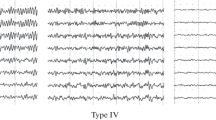Abstract
Heart beats of unrestrained Carcinus maenas L. have been recorded by means of aspiration electrodes. The heart rate shows a clear dependence upon the oxygen content of the sea water under otherwise constant conditions. There is a high degree of correlation between heart rate and oxygen concentration in the range between 0 cm3 and ca. 6 cm3 O2/I sea water. From this point upwards no further dependence could be found. Very low (beneath 0.5 cm3 O2/I water) and very high (over 12 cm3 O2/I water) concentrations lead to arrhythmia and often to long lasting intervals in the heart beats. It is suggested that this correlation is due to the oxygen-dependent excitability of the neurones generating the beats in the neurogenic hearts of crustaceans.
Zusammenfassung
-
1.
Mit Hilfe von Pt-Aspiratioselektroden wurden die Herzfrequenzen ungestörter, frei beweglicher Carcinus maenas L. registriert und bei Konstanz der übrigen Faktoren der Einfluß des O2-Gehalts auf die Herzfrequenz untersucht.
-
2.
Die Herzfrequenz von C. maenas zeigt eine deutliche Abhängigkeit vom O2-Gehalt des Meerwassers.
-
3.
Zwischen 0 und 6 ml O2/l Meerwasser besteht eine statistisch in hohem Maße gesicherte Korrelation zwischen O2-Gehalt und Herzfrequenz: mit steigendem Sauerstoffgehalt werden die Herzfrequenzen erhöht. Oberhald dieses Sättigungspunktes konnte keine Abhängigkeit mehr gefunden werden. Es wird vermutet, daß dieses Phänomen mit der neurogenen Tätigkeit des Krebsherzens in Verbindung steht.
Similar content being viewed by others
Zitierte Literatur
Dauscher, H. und R. Flindt: Vergleichende Untersuchungen zur Herztätigkeit bei frei beweglichen dekapoden Krebsen (Astacus fluviatilis Fab., Astacus leptodactylus Eschscholz und Cambarus affinis Say). Z. vergl. Physiol. 62, 291–300 (1969).
Florey, E.: Studies on the nervous regulation of heart beat in decapod crustacea. J. gen: Physiol. 43, 1061–1081 (1960).
Larimer, J. L.: Sensory-induced modifications of ventilation and heart rate in crayfish. Comp. Biochem. Physiol. 12, 25–36 (1964).
Mislin, H.: Experimenteller Nachweis der Beeinflussung des Elektrocardiogramms (EKG) dekapoder Krebse (Astacus fluviatilis F., Astacus leptodactylus E., Carcinus maenas L). durch optische Reize (Optocardialer Hemmreflex). Revue suisse Zool. 73, 301–312 (1966).
Prosser, C. L. and F. A. Brown, Jr.: Comparative animal physiology, 2nd ed. 688 pp. London-Philadelphia: W. B. Saunders 1962.
Randall, D. J. and G. Shelton: The effects of changes in environmental gas concentrations on the breathing and heart rate of a teleost fish. Comp. Biochem. Physiol. 9, 229–239 (1963).
Schwartzkopff, J.: Vergleichende Untersuchung der Herzfrequenz bei Krebsen. Biol. Zbl. 74, 480–497 (1955).
Author information
Authors and Affiliations
Additional information
Communicated by O. Kinne, Hamburg
Rights and permissions
About this article
Cite this article
Flindt, R. Zur Abhängigkeit des Herzschlags vom O2-Gehalt des Wassers bei Carcinus maenas . Marine Biology 9, 224–227 (1971). https://doi.org/10.1007/BF00351383
Accepted:
Issue Date:
DOI: https://doi.org/10.1007/BF00351383




